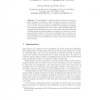Free Online Productivity Tools
i2Speak
i2Symbol
i2OCR
iTex2Img
iWeb2Print
iWeb2Shot
i2Type
iPdf2Split
iPdf2Merge
i2Bopomofo
i2Arabic
i2Style
i2Image
i2PDF
iLatex2Rtf
Sci2ools
MASCOTS
2003
2003
Computer Virus Propagation Models
Abstract. The availability of reliable models of computer virus propagation would prove useful in a number of ways, in order both to predict future threats, and to develop new containment measures. In this paper, we review the most popular models of virus propagation, analyzing the underlying assumptions of each of them, their strengths and their weaknesses. We also introduce a new model, which extends the Random Constant Spread modeling technique, allowing us to draw some conclusions about the behavior of the Internet infrastructure in presence of a self-replicating worm. A comparison of the results of the model with the actual behavior of the infrastructure during recent worm outbreaks is also presented.
Computer Virus Propagation | MASCOTS 2003 | MASCOTS 2007 | Random Constant Spread | Virus Propagation |
| Added | 31 Oct 2010 |
| Updated | 31 Oct 2010 |
| Type | Conference |
| Year | 2003 |
| Where | MASCOTS |
| Authors | Giuseppe Serazzi, Stefano Zanero |
Comments (0)

